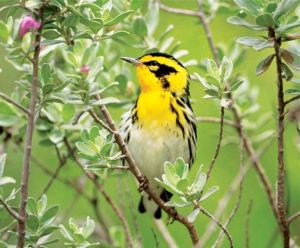
One of the most exciting components of the spring neo-tropical bird migration is the mass movement of warblers through the Lower Rio Grande Valley.
Of the 57 warblers that breed in North America, many pass through the area along the Central Flyway on their way to nesting grounds in more northern parts of the United States and Canada.
The warbler migration is one of nature’s great spectacles. They are like ornaments that adorn trees and bushes with their bright colors, nervous dispositions and big appetites. They are among the most beautiful birds in North America.
I once read a story about a woman who was asked what her favorite warbler was. She replied “the last one I see.” I think a lot of birders and bird photographers can relate to that.
At various times, my favorite warbler has been the cerulean, or the Cape May, or the Blackburnian, or maybe the prothonotary, or possibly the golden-winged. Tomorrow, it may be the bay-breasted, or the black-and-white, or the magnolia. You get the picture.
A few have special significance that go beyond their beauty.
For example, the yellow warbler is the first wood warbler I remember seeing and that came many years ago at Aransas National Wildlife Refuge. The first one I photographed was a yellow-throated warbler, and that was at South Padre Island. Another warbler that has special significance is the prothonotary because it nests in the part of Texas I’m from.
It’s one of nature’s great miracles that these tiny birds are able to navigate 600 miles or so across the Gulf of Mexico at night and arrive in the Valley. Many are so fatigued they are unable to keep out of harm’s way.
I remember an incident several years ago during the spring migration on South Padre Island. I was getting ready to call it a day when I noticed a Tennessee warbler landing on a bush in front of me. I could tell it had just crossed the Gulf and was completely exhausted. I decided to watch the warbler for a few minutes to make certain it was going to be OK.
Shortly thereafter the sun set and the warbler found just enough energy to drop to the ground and slip under a railroad tie to spend the night. The next morning, I checked to see if the warbler was still there but it wasn’t. I would like to think the bird made it through the night, regained its strength and eventually continued its northward journey.
As tough as that Tennessee warbler had it, nothing compares to the journey of the Blackpoll warbler, which frequents the Valley during the migration. This striking warbler winters in Brazil and travels several thousand miles to nesting grounds in Canada and Alaska. That’s nothing short of miraculous.
But then that shouldn’t surprise me. Warblers, after all, are incredible birds and prove that beauty can be found in even the smallest package.
Visit the SPI Birding & Nature Center
Steve Sinclair
The Coastal Current
May 5, 2014




